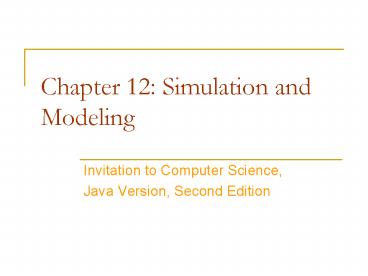Chapter 12: Simulation and Modeling - PowerPoint PPT Presentation
1 / 21
Title:
Chapter 12: Simulation and Modeling
Description:
Simulation and modeling. Probably the single most important scientific ... Design and carry out experiments to prove or disprove the validity of the hypothesis ... – PowerPoint PPT presentation
Number of Views:30
Avg rating:3.0/5.0
Title: Chapter 12: Simulation and Modeling
1
Chapter 12 Simulation and Modeling
- Invitation to Computer Science,
- Java Version, Second Edition
2
Introduction
- Simulation and modeling
- Probably the single most important scientific use
of computing today - Having an impact on quantitative fields, such as
chemistry, biology, medicine, meteorology,
ecology, geography, economics, etc.
3
Computational Modeling Introduction to Systems
and Models
- The scientific method
- Observe the behavior of a system
- Formulate a hypothesis about system behavior
- Design and carry out experiments to prove or
disprove the validity of the hypothesis - Often a model of the system is used
4
Introduction to Systems and Models (continued)
- A model
- An abstraction of the system being studied that
we claim behaves much like the original - Computer simulation
- A physical system is modeled as a set of
mathematical equations and/or algorithmic
procedures
5
Introduction to Systems and Models (continued)
- Computer simulation (continued)
- Model is translated into a high-level language
and executed on the Von Neumann computer - Computational models
- Also called simulation models
- Used to
- Design new systems
- Study and improve the behavior of existing systems
6
Introduction to Systems and Models (continued)
- Computational models (continued)
- Allow the use of an interactive design
methodology (sometimes called computational
steering) - Used in most branches of science and engineering
7
Computational Models, Accuracy, and Errors
- Proper balance between accuracy and complexity
must be achieved - A model must be both
- An accurate representation of the physical system
- Simple enough to implement as a program and solve
on a computer in a reasonable amount of time
8
Computational Models, Accuracy, and Errors
(continued)
- To build a model
- Include important factors that act on the system
- Omit unimportant factors that only make the model
harder to build, understand, and solve
9
Computational Models, Accuracy, and Errors
(continued)
- Continuous model
- A set of equations that describe the behavior of
a system as a continuous function of time t - Models that use statistical approximations
- Needed for systems that cannot be modeled using
precise mathematical equations
10
Running the Model and Visualizing Results
- Scientific visualization
- Visualizing data in a way that highlights its
important characteristics and simplifies its
interpretation - An important part of computational modeling
- Different from computer graphics
11
Running the Model and Visualizing Results
(continued)
- Scientific visualization is concerned with
- Data extraction which data values are important
to display and which are not - Data manipulation convert the data to other
forms or to different units to enhance display
12
Running the Model and Visualizing Results
(continued)
- Output of a computer model can be represented
visually, such as through - A two-dimensional graph
- A three-dimensional image
- Visual representation of data helps identify
important features of the models output
13
- Figure 12.10 Using a Two-Dimensional Graph to
Display and Compare Two Data Values
14
- Figure 12.11
- Three-Dimensional Image of a Region of the
Earths Surface
15
- Figure 12.12
- Three-Dimensional Model of a Methyl Nitrite
Molecule
16
- Figure 12.13
- Visualization of Gas Dispersion
17
Running the Model and Visualizing Results
(continued)
- Image animation
- One of the most powerful and useful forms of
visualization - Shows how models output changes over time
- Created using many images, each showing system
state at a slightly later point in time
18
- Figure 12.14
- Use of Animation to Model Ozone Layers in the
Atmosphere
19
Summary
- A model is an abstraction of a system that
behaves much like the original - Computer simulation
- Physical system is modeled using mathematical
equations and/or algorithmic procedures - Model is translated into a high-level language
program and executed
20
Summary
- Computational models allow the use of an
interactive design methodology - Scientific visualization visualizing data to
highlight its important characteristics and
simplify its interpretation
21
Key Terms































